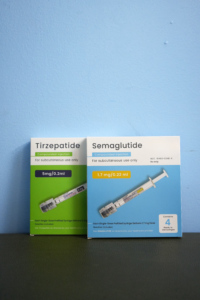- Uncategorized
-
by Skippack Pharmacy
Have you or someone you know ever struggled with obesity? Imagine it’s 2010. You desperately want to lose weight, but maintaining a restrictive diet feels impossible while balancing work and life. Exercise seems like an unattainable commitment, and when you seek medical help, your options are limited to medications with difficult side effects or surgical interventions that feel too extreme. You wish there were a safe, effective medication to support weight loss—without these challenges.
A decade ago, this was the reality for many. Obesity and overweight conditions affected nearly 70% of Americans, and traditional weight-loss methods often failed to deliver long-term results. That changed with the introduction of GLP-1 receptor agonists, which have proven to be both safer and more effective for sustained weight loss. But where do these medications come from?

The Evolution of GLP-1 Medications
The First Generation
In 2014, the first FDA-approved GLP-1 receptor agonist for weight loss became available. This twice-daily injectable led to an average 7% reduction in body weight over a year. It quickly gained popularity due to its relatively mild side effects—primarily nausea, headaches, and injection site pain—along with its ability to support long-term weight loss.
A Major Breakthrough
For several years, early GLP-1 medications remained the primary options for obesity treatment. That changed in 2021 with the introduction of a more advanced formulation requiring only a once-weekly injection, making it significantly more convenient. Clinical trials showed that this new treatment led to up to 10% weight loss over 104 weeks, making it more effective than previous versions.
By 2022, its approval expanded to adolescents aged 12 and older, broadening its reach. Then, in 2024, it became the first GLP-1 medication approved in the U.S. to reduce cardiovascular risk in overweight and obese patients with heart conditions. These advantages led to an overwhelming surge in demand, contributing to national shortages.
The Newest Option
A newer GLP-1 medication entered the market in 2023, offering an even greater potential for weight loss. Like its predecessor, this treatment is a once-weekly injection, but clinical trials revealed an unprecedented 20% weight loss over 72 weeks—a significant improvement over earlier options. With a slightly lower price point, it quickly became one of the most sought-after GLP-1 medications for obesity.
The Current Landscape
The growing popularity of GLP-1 treatments has led to supply shortages, making availability inconsistent at pharmacies nationwide. If you and your doctor are considering starting a GLP-1 medication, it’s best to call your local pharmacy to check stock.
If you’d like to learn more about these weight-loss treatments, click here for additional information.
Best of luck on your weight-loss journey!
Written By: Sharon Choi and Steven Dao, Temple University PharmD Students